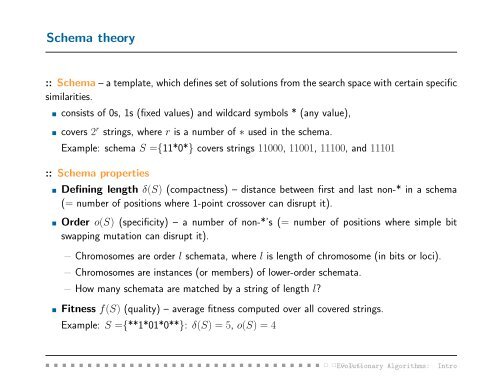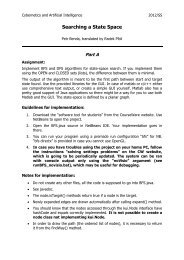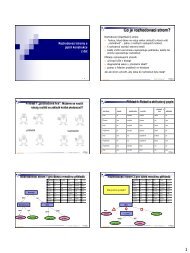Evolutionary Algorithms: Introduction Jiˇr´ı Kubal´ık Department of ...
Evolutionary Algorithms: Introduction Jiˇr´ı Kubal´ık Department of ...
Evolutionary Algorithms: Introduction Jiˇr´ı Kubal´ık Department of ...
You also want an ePaper? Increase the reach of your titles
YUMPU automatically turns print PDFs into web optimized ePapers that Google loves.
pSchema theory<br />
:: Schema – a template, which defines set <strong>of</strong> solutions from the search space with certain specific<br />
similarities.<br />
consists <strong>of</strong> 0s, 1s (fixed values) and wildcard symbols * (any value),<br />
covers 2 r strings, where r is a number <strong>of</strong> ∗ used in the schema.<br />
Example: schema S ={11*0*} covers strings 11000, 11001, 11100, and 11101<br />
:: Schema properties<br />
Defining length δ(S) (compactness) – distance between first and last non-* in a schema<br />
(= number <strong>of</strong> positions where 1-point crossover can disrupt it).<br />
Order o(S) (specificity) – a number <strong>of</strong> non-*’s (= number <strong>of</strong> positions where simple bit<br />
swapping mutation can disrupt it).<br />
− Chromosomes are order l schemata, where l is length <strong>of</strong> chromosome (in bits or loci).<br />
− Chromosomes are instances (or members) <strong>of</strong> lower-order schemata.<br />
− How many schemata are matched by a string <strong>of</strong> length l?<br />
Fitness f(S) (quality) – average fitness computed over all covered strings.<br />
Example: S ={**1*01*0**}: δ(S) = 5, o(S) = 4<br />
<strong>Evolutionary</strong> <strong>Algorithms</strong>: Intro












![RANSAC [Fischler, Bolles '81]](https://img.yumpu.com/17549294/1/190x143/ransac-fischler-bolles-81.jpg?quality=85)



